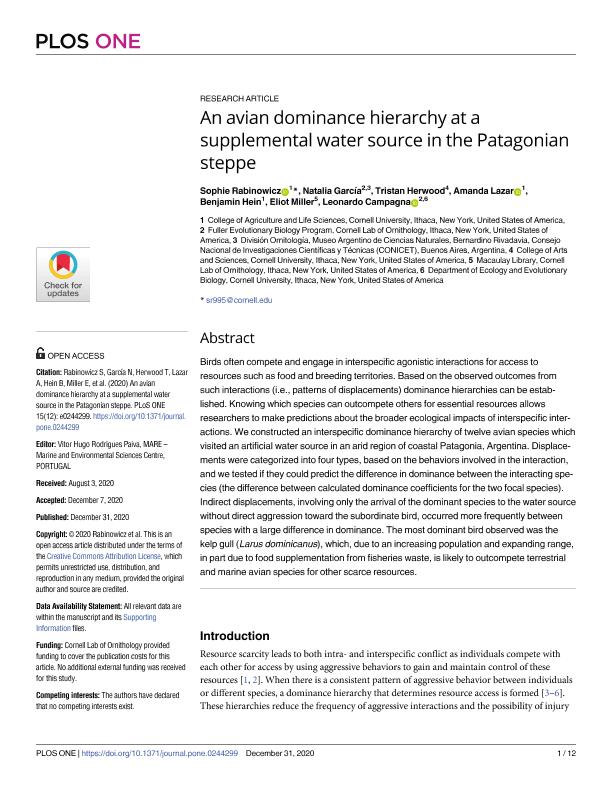Mostrar el registro sencillo del ítem
dc.contributor.author
Rabinowicz, Sophie
dc.contributor.author
García, Natalia Cristina

dc.contributor.author
Herwood, Tristan
dc.contributor.author
Lazar, Amanda
dc.contributor.author
Hein, Benjamin
dc.contributor.author
Miller, Eliot
dc.contributor.author
Campagna, Leonardo

dc.date.available
2022-01-18T15:27:20Z
dc.date.issued
2020-12
dc.identifier.citation
Rabinowicz, Sophie; García, Natalia Cristina; Herwood, Tristan; Lazar, Amanda; Hein, Benjamin; et al.; An avian dominance hierarchy at a supplemental water source in the Patagonian steppe; Public Library of Science; Plos One; 15; 12; 12-2020; 1-12
dc.identifier.issn
1932-6203
dc.identifier.uri
http://hdl.handle.net/11336/150235
dc.description.abstract
Birds often compete and engage in interspecific agonistic interactions for access to resources such as food and breeding territories. Based on the observed outcomes from such interactions (i.e., patterns of displacements) dominance hierarchies can be established. Knowing which species can outcompete others for essential resources allows researchers to make predictions about the broader ecological impacts of interspecific interactions. We constructed an interspecific dominance hierarchy of twelve avian species which visited an artificial water source in an arid region of coastal Patagonia, Argentina. Displacements were categorized into four types, based on the behaviors involved in the interaction, and we tested if they could predict the difference in dominance between the interacting species (the difference between calculated dominance coefficients for the two focal species). Indirect displacements, involving only the arrival of the dominant species to the water source without direct aggression toward the subordinate bird, occurred more frequently between species with a large difference in dominance. The most dominant bird observed was the kelp gull (Larus dominicanus), which, due to an increasing population and expanding range, in part due to food supplementation from fisheries waste, is likely to outcompete terrestrial and marine avian species for other scarce resources.
dc.format
application/pdf
dc.language.iso
eng
dc.publisher
Public Library of Science

dc.rights
info:eu-repo/semantics/openAccess
dc.rights.uri
https://creativecommons.org/licenses/by-nc-sa/2.5/ar/
dc.subject
birds
dc.subject
dominance hierarchy
dc.subject
Patagonia
dc.subject.classification
Zoología, Ornitología, Entomología, Etología

dc.subject.classification
Ciencias Biológicas

dc.subject.classification
CIENCIAS NATURALES Y EXACTAS

dc.title
An avian dominance hierarchy at a supplemental water source in the Patagonian steppe
dc.type
info:eu-repo/semantics/article
dc.type
info:ar-repo/semantics/artículo
dc.type
info:eu-repo/semantics/publishedVersion
dc.date.updated
2021-11-17T14:53:22Z
dc.journal.volume
15
dc.journal.number
12
dc.journal.pagination
1-12
dc.journal.pais
Estados Unidos

dc.journal.ciudad
San Francisco
dc.description.fil
Fil: Rabinowicz, Sophie. Cornell University; Estados Unidos
dc.description.fil
Fil: García, Natalia Cristina. Consejo Nacional de Investigaciones Científicas y Técnicas. Oficina de Coordinación Administrativa Parque Centenario. Museo Argentino de Ciencias Naturales "Bernardino Rivadavia"; Argentina
dc.description.fil
Fil: Herwood, Tristan. Cornell University; Estados Unidos
dc.description.fil
Fil: Lazar, Amanda. Cornell University; Estados Unidos
dc.description.fil
Fil: Hein, Benjamin. Cornell University; Estados Unidos
dc.description.fil
Fil: Miller, Eliot. Cornell Lab of Ornithology; Estados Unidos
dc.description.fil
Fil: Campagna, Leonardo. Consejo Nacional de Investigaciones Científicas y Técnicas. Oficina de Coordinación Administrativa Parque Centenario. Museo Argentino de Ciencias Naturales "Bernardino Rivadavia"; Argentina. Cornell University; Estados Unidos
dc.journal.title
Plos One

dc.relation.alternativeid
info:eu-repo/semantics/altIdentifier/doi/http://dx.doi.org/10.1371/journal.pone.0244299
dc.relation.alternativeid
info:eu-repo/semantics/altIdentifier/url/https://journals.plos.org/plosone/article?id=10.1371/journal.pone.0244299
Archivos asociados
